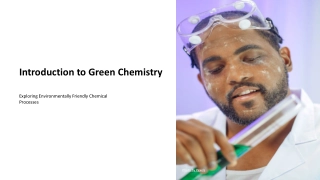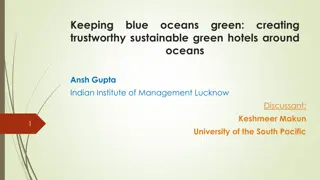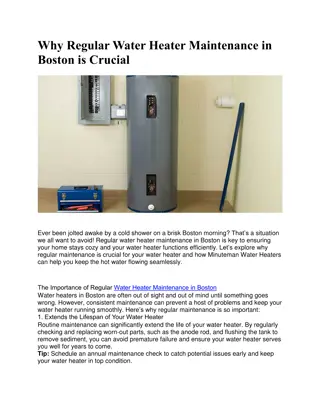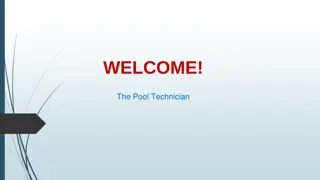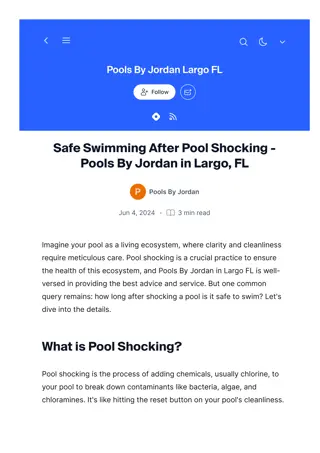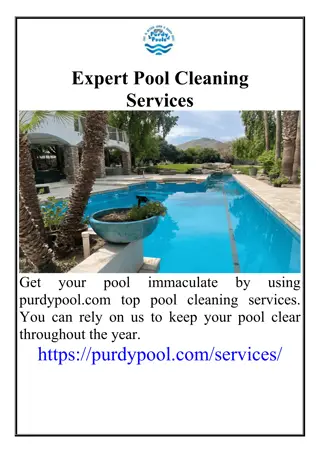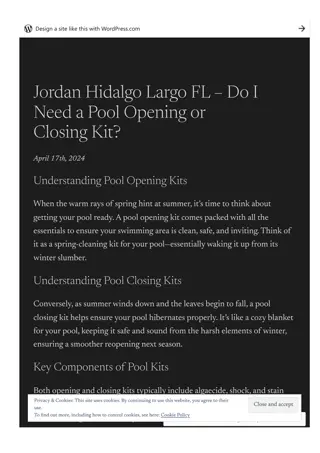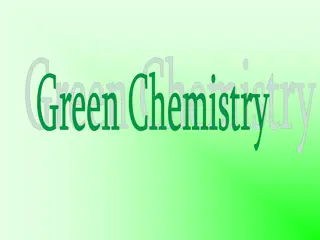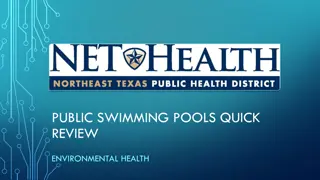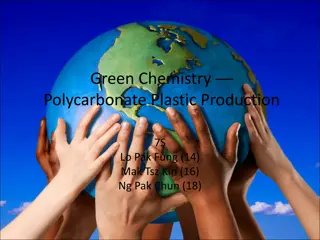Green Chemistry and Pool Water Maintenance
These slides cover topics related to green chemistry principles, water sterilization, purification methods, swimming pool chemistry, and maintenance. They highlight the importance of clean water for drinking, the challenges faced in water treatment, and the chemistry involved in keeping swimming pools safe and aesthetically pleasing. The content delves into issues like water contamination, pool problems, chlorination, pH balance, and the use of chemicals in pool maintenance. Various disinfection methods and their effectiveness in killing pathogens are also discussed.
Download Presentation

Please find below an Image/Link to download the presentation.
The content on the website is provided AS IS for your information and personal use only. It may not be sold, licensed, or shared on other websites without obtaining consent from the author.If you encounter any issues during the download, it is possible that the publisher has removed the file from their server.
You are allowed to download the files provided on this website for personal or commercial use, subject to the condition that they are used lawfully. All files are the property of their respective owners.
The content on the website is provided AS IS for your information and personal use only. It may not be sold, licensed, or shared on other websites without obtaining consent from the author.
E N D
Presentation Transcript
These slides contain animations, when the PowerPoint file is played The content gradually appears with clicks Questions appear before their answers
Green Chemistry and Living in the Desert Water Staying alive drinking Clean water for drinking, what are the problems? How is water sterilized, chlorine, UV, ozone How is water purified? Distillation, reverse osmosis, deionization, charcoal. Drink containers - Recycling Cooling off Swimming pool chemistry Chlorine, pH, buffers, water hardness Cleaning detergents, dishwashing, laundry Biodegradation, algal blooms, eutrophication
Cooling Off Swimming Pools Going for a swim is a great way to cool off! Keeping a swimming pool both safe and aesthetically pleasing requires careful maintenance of the water Chemistry plays a critical role in doing this What are some problems that a pool can have?
Cooling Off Swimming Pools What are some problems that a pool can have? Remedy Filtration Poor Appearance? Dirt, leaves, insect bodies, other solids Scale buildup Green water Corrosion of metal parts Strong smell Decrease dissolved salts Chlorination Balance pH Chlorination Safety/Effects on people? Transmit disease Burn eyes Bleach hair/clothes Turn hair green Too cold/hot Chlorination Balance pH Chlorination Chelating agent Let s look at some of these in more detail
Swimming Pool Chemistry Maintaining pool chemistry involves using chemicals to control the following: Chlorination pH Buffer level Stabilizer level Dissolved salts/Water hardness Some chemicals may need to be added less frequently: Algaecide Water clarifier/flocculant Copper remover Phosphate remover
Swimming Pool Chemistry - Chlorination What does chlorine do? Chlorine is a disinfectant The aim is to kill any organisms in the pool and to inactivate viruses A relatively low level of chlorine in the water is quite effective at killing bacteria, parasites, fungi, algae, and destroying viruses without causing much problem for human swimmers Other less commonly used disinfection methods include: Bromine Ozone UV light Hydrogen peroxide/UV light
Swimming Pool Chemistry - Chlorination Chlorine (Cl2) While chloride (Cl-) is necessary for all know species of life, chlorine (Cl2) is poisonous to most living organisms Chlorine is a yellow-green gas! bp -34 C So how are all these things chlorine ?: Wikipedia - chlorine https://images.app.goo.gl/euFU3TK4k8XqtMrL6 https://images.app.goo.gl/g5nie2hbBK6CseaE6
Swimming Pool Chemistry - Chlorination Chlorine reacts with water to form hypochlorous acid: Cl2(g) + H2O HOCl + H+ + Cl- Hypochlorous acid is in equilibrium with its dissociated form: HOCl + H+ + OCl- Which species are present in water is highly dependent on pH At pH 7.5 (typical pool pH) and 25 C, the amounts of hypochlorous acid (HOCl) and hypochlorite ion (-OCl) are about equal In strongly acidic water (low pH [~2]) chlorine is mostly present as dissolved Cl2 In basic water (pH > 8) chlorine is mostly present as hypochlorite ion (-OCl)
Swimming Pool Chemistry - Chlorination HOCl + -OCl -OCl Cl2 pH At pH 7.5 (typical pool pH) and 25 C, the amounts of hypochlorous acid (HOCl) and hypochlorite ion (-OCl) are about equal In strongly acidic water (low pH [~2]) chlorine is mostly present as dissolved Cl2 In basic water (pH > 8) chlorine is mostly present as hypochlorite ion (-OCl) The sanitizing effect is better when there is more HOCl/Cl2 present However, Cl2 will escape at some rate from the system
Swimming Pool Chemistry - Chlorination So, what are these?: This Chlorine is solid calcium hypochlorite (Ca(OCl)2) Reaction with acid in the pool will generate HOCl, which is in equilibrium with Cl2 This Chlorine is an aqueous solution of sodium hypochlorite (NaOCl) Unlike calcium hypochlorite, it is not stable in solid form and is always used as a solution
Swimming Pool Chemistry - Chlorination These tablets are made from trichloroisocyanuric acid These react with acid to form chlorine (Cl2) The same reaction occurs to release all three chlorines
Swimming Pool Chemistry - Stabilizer The reverse reaction of chlorine release can also occur to add Cl to isocyanuric acid Cyanuric acid is added to the pool as a stabilizer , it reversibly binds some of the free chlorine, effectively giving a slower release, so giving a slower loss of chlorine
Swimming Pool Chemistry - pH HOCl + -OCl -OCl Cl2 pH Hypochlorite ion (-OCl) is not as effective at sanitizing as hypochlorous acid/chlorine This means the water should not be too basic (high pH) as it will lower the sanitizing power of the chlorine However, when there is more Cl2 present in the water, it can leave the water as a gas and be lost So, there is a balance between having a decent amount of free chlorine present and it being lost as a gas from the water, this is controlled by the pH
Swimming Pool Chemistry - pH HOCl + -OCl -OCl Cl2 pH But the water can t just be any pH, the swimmers will not tolerate the water if it is too basic or too acidic When eye irritation occurs in a swimming pool the most likely cause is low pH (acidic). Human tears have pH ~7.0-7.4. That is a good target for the pool. Low pH (acidic) also speeds corrosion of metal parts in the pool https://images.app.g oo.gl/9wa2qBCKq54b MmbZA
Swimming Pool Chemistry - pH How is pH adjusted? Lower the pH make it more acidic Most commonly - add concentrated hydrochloric acid! Aka muriatic acid Isn t that dangerous? Yes! Contact with skin will cause immediate burns, contact with eyes will cause catastrophic damage Additionally, the fumes coming from concentrated HCl are noxious and corrosive Safer solid acid sources such as NaHSO4 are also available, however they are generally much more expensive
Swimming Pool Chemistry - pH How is pH adjusted? Increase the pH make it more basic Most commonly - add solid Na2CO3 Could add e.g. NaOH, but Na2CO3 is sufficiently basic and more easily handled, safer, and stable for storage
Swimming Pool Chemistry - Buffer A buffer is typically used with the pool water Aka total alkalinity increaser This is usually solid sodium bicarbonate (NaHCO3) What is a buffer? Why is it used? Adding a small amount of acid or base to the pool can cause a large swing in pH. Similarly, the pH can vary widely when the acid concentration changes for other reasons A buffer helps to maintain a near constant pH, even when sizable amounts of acid or base are added: -OH H+ CO32- HCO3- H2CO3


